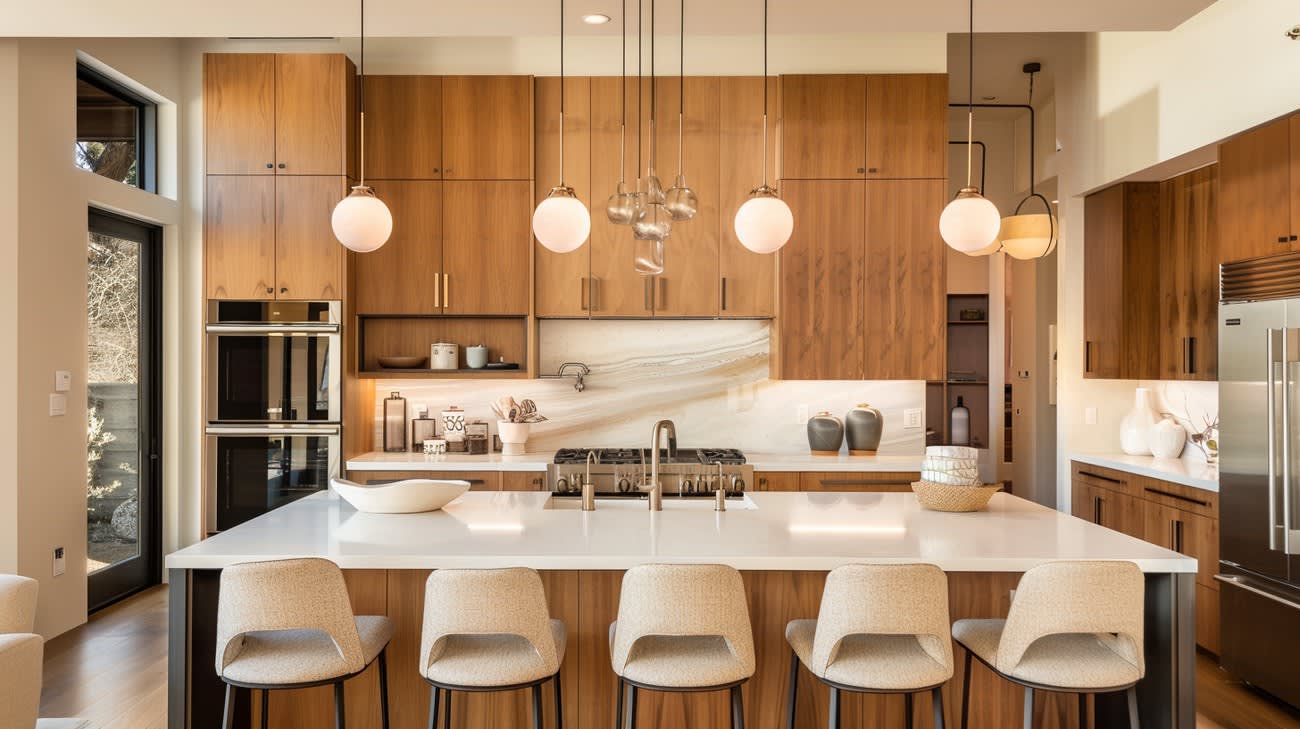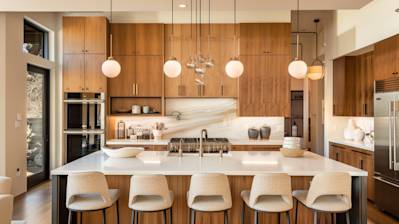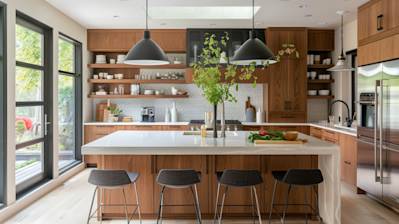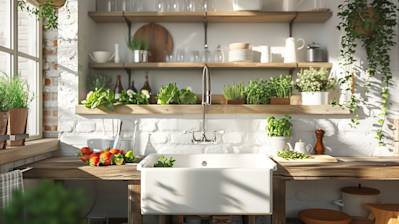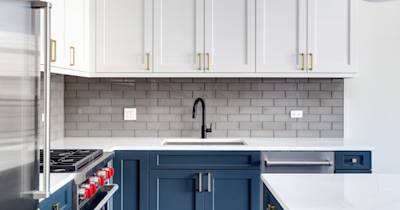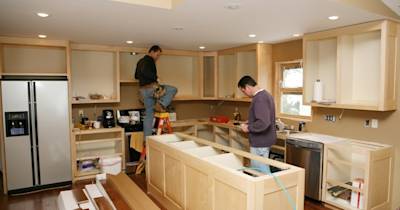Lighting is a crucial element in home design, and kitchen pendant lights have become a popular choice for homeowners looking to enhance their kitchen's aesthetics and functionality. These versatile fixtures can dramatically transform your space, whatever your style or layout. Dive in to explore everything you need to know about choosing and utilizing kitchen pendant lights.
Why Choose Kitchen Pendant Lights?
Kitchen pendant lights provide focused illumination that can enhance both your culinary tasks and the ambiance of your kitchen. With numerous designs, sizes, and finishes available, pendant lights offer a great way to express your personal style. Their strategic placement can improve visibility and add a touch of elegance.
Types of Pendant Lights
Understanding the different types of pendant lights is crucial before making a purchase. Here's a rundown of the key styles:
Mini Pendant Lights
Perfect for small kitchens or spaces where subtlety is preferred, mini pendant lights offer a sleek look. They're ideal for creating a series along a countertop or an island, offering uniform light without overwhelming the space.
Multi-Light Pendants
These pendants cluster multiple lights under a single fixture. They are great for areas that require bright, ample light, adding complexity and dimension to your design approach.
Inverted Pendant Lights
Inverted pendant lights work well to provide ambient lighting. Their upward-facing design diffuses light, offering a softer mood and reducing harsh shadows in the kitchen.
Drum Pendant Lights
With their cylindrical shape, drum pendant lights add a modern touch while providing efficient lighting perfect for precise tasks. They come in various materials, from fabric to metal, allowing for design flexibility.
Materials and Finishes
Selecting the right material and finish is essential for aligning your pendant lights with your kitchen decor. Consider these popular choices:
- Glass Pendants: Offer a clean, modern look. Available in frosted, clear, or colored varieties, they work well with any style.
- Metal Pendants: Robust and industrial. Finishes can range from chrome and brass to matte black or copper, fitting various kitchen themes.
- Fabric Pendants: Offer a softer, more traditional appearance. They work best in contemporary or farmhouse-style kitchens.
Size and Placement Tips
Choosing the right size and strategically placing your pendant lights is as important as the style:
- Over Kitchen Islands: Aim for pendants that are proportional to your island size. Large islands can handle bigger or multiple pendants, while smaller islands benefit from a single fixture.
- Above Dining Areas: Use a pendant that's about a third of the table's width. Hang it 30-36 inches above the table for optimal illumination.
- General Lighting: Ensure your pendants complement the existing lights, providing even coverage without excessive overlapping of light.
Considerations for Height and Spacing
Getting the height and spacing right will ensure your pendant lights are both functional and aesthetically pleasing:
- Height: For kitchen islands, the standard hanging height is 28-34 inches above the surface.
- Spacing: A space of about 24-30 inches between pendant lights ensures light distribution is balanced and prevents crowding.
Popular Design Trends
Stay ahead of the curve by incorporating these popular pendant lighting trends:
- Eco-Friendly Designs: Energy-efficient LED pendants with a minimal footprint are becoming more popular, offering sustainable choices.
- Matte Black Finishes: Timeless and versatile, matte black blends with any kitchen style, providing a classic and sophisticated touch.
- Bold Geometric Shapes: Pendants with unique shapes serve as a focal point, adding artistic flair to your kitchen.
Installation Tips
Proper installation ensures safety and maximizes the impact of your pendant lights:
- Consider hiring a professional electrician, particularly if new wiring is required.
- Use dimmer switches to adjust lighting levels according to your needs.
- Double-check your ceiling type and mounting box compatibility before installation.
Match Pendants with Kitchen Decor
To tie your lighting fixtures with the overall kitchen design, consider these coordination tips:
- Select colors that either complement or contrast with kitchen cabinetry and hardware.
- Match pendant light materials with your appliances for a cohesive look.
- Keep in line with your kitchen's theme, whether modern, rustic, or transitional.
Enhance Kitchen Functionality
The right pendant lights do more than beautify; they improve kitchen functionality significantly:
- Task Lighting: Place pendants strategically for activities like cooking, preparing meals, or dining.
- Mood Setting: Use dimmable pendants to transition between bright task lighting and soft, ambient lighting.
- Space Definition: Pendant lights can distinguish different zones in open-plan kitchens.
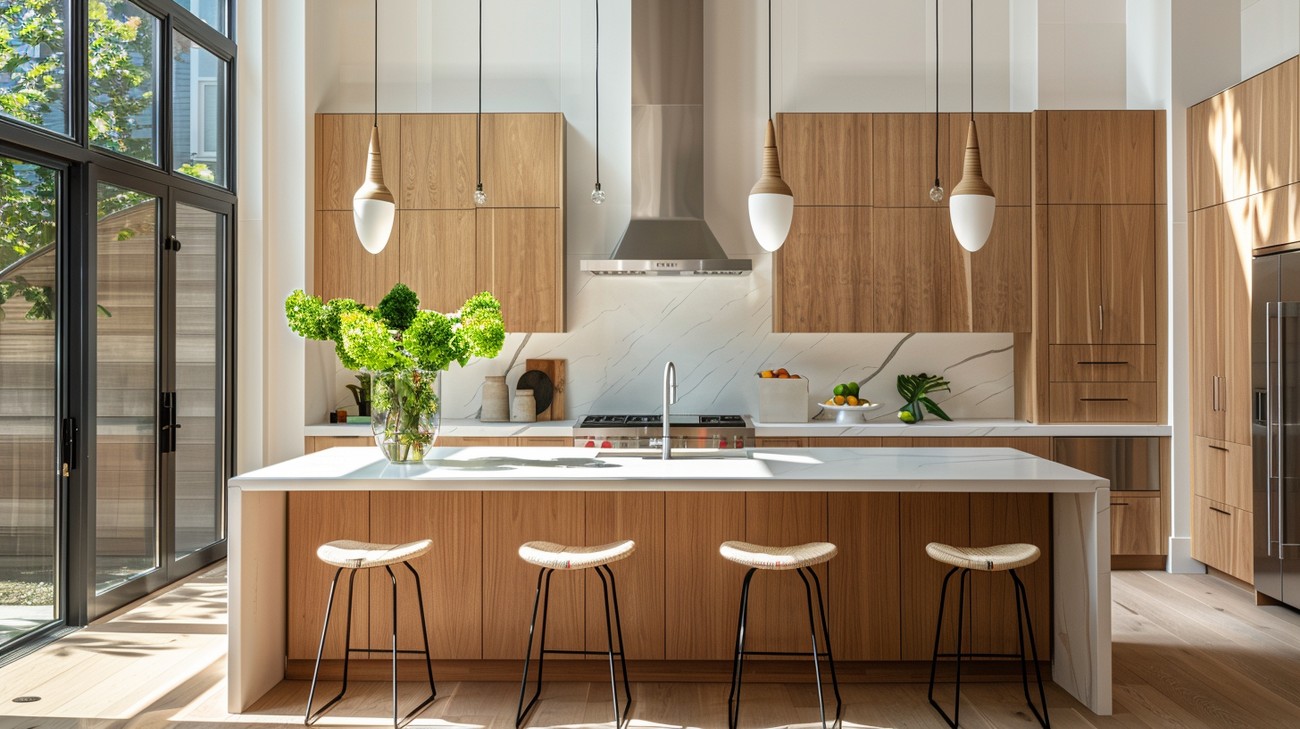
FAQ: Kitchen Pendant Lights
What are kitchen pendant lights best used for?
Kitchen pendant lights are perfect for providing focused lighting over key areas in the kitchen, such as islands or dining tables. They are a great choice for task lighting, making meal preparation easier and safer. Pendant lighting can also create ambiance and serve as a decorative focal point, enhancing the overall design aesthetic of your kitchen.
How do you decide the height for hanging kitchen pendant lights?
The ideal hanging height for kitchen pendant lights is generally between 28 to 34 inches above kitchen islands or countertops. This height minimizes glare while ensuring the lighting illuminates the workspace effectively. However, the perfect height can vary based on ceiling height and personal preference. Always consider the specific needs of your space when adjusting pendant light height.
Are kitchen pendant lights energy efficient?
Kitchen pendant lights can be energy efficient, especially when fitted with LED bulbs. LEDs use significantly less electricity and last longer than traditional incandescent bulbs. When selecting kitchen pendant lighting, look for energy-efficient fixtures and bulbs to reduce energy consumption and long-term costs without compromising on style or light quality.
Can kitchen pendant lights be the primary light source?
While kitchen pendant lights provide excellent task lighting, they are typically best complemented by other lighting sources. An effective kitchen lighting plan incorporates layers of light, including ambient, task, and accent lighting. Use pendant lighting alongside recessed or ceiling-mounted fixtures to achieve adequate illumination throughout the kitchen.
How do you choose the style of kitchen pendant lights?
Choosing the right style for kitchen pendant lights involves considering the overall design theme of your space. For a modern kitchen, opt for sleek, minimalist designs with metal or glass finishes. A rustic or farmhouse kitchen can be complemented with pendant lights featuring wood, wrought iron, or vintage elements. Pay attention to the color and finish to ensure the pendant lights harmonize with existing fixtures and decor.
How many pendant lights do you need over a kitchen island?
The number of pendant lights needed over a kitchen island depends on the island’s size and the diameter of the pendants. Generally, three pendant lights are sufficient for most kitchen islands. However, if the pendants are particularly large, two may be enough. Space them evenly to ensure uniform lighting and avoid overcrowding the visual space.
Can kitchen pendant lights be installed on sloped ceilings?
Yes, many kitchen pendant lights can be installed on sloped ceilings. When selecting pendant lighting for such ceilings, ensure the fixture has an adjustable rod or chain that can accommodate the angle. This flexibility will help keep the pendant lights level and hang correctly, maintaining both functionality and aesthetic appeal.
What types of bulbs are suitable for kitchen pendant lights?
When choosing bulbs for kitchen pendant lights, consider LED bulbs for their efficiency and longevity. They provide bright, clear light ideal for task illumination. Avoid overly warm bulbs that might not provide sufficient brightness, particularly if the pendant lights are your main source of task lighting. Dimmable bulbs are also a good choice, offering flexibility in adjusting the light levels to suit different activities or times of day.
How do you clean and maintain kitchen pendant lights?
Regular cleaning and maintenance of kitchen pendant lights involve dusting the fixtures and cleaning the shades or glass components. Use a soft cloth or microfiber duster to remove dust, and a damp cloth for any stubborn spots. For glass shades, consider a mild detergent solution but avoid harsh chemicals that could damage the finish. Consistently check for any loose fixtures or burnt-out bulbs to keep your pendant lights in optimal condition.
Can kitchen pendant lights be connected with smart home systems?
Many modern kitchen pendant lights are compatible with smart home systems. Look for fixtures that support smart bulbs or have built-in smart capabilities. With smart pendant lighting, you can control lighting levels, color temperature, and schedules from your smartphone or smart home device, enhancing both convenience and energy efficiency in your kitchen.

Buyer's Guide: What to Look For
Key Factors to Consider
1. Style and Design:
Start by considering the overall aesthetic you wish to achieve. Is your kitchen modern, rustic, industrial, or traditional? Pendant lights come in a variety of styles, from sleek metals to intricate glass designs. Also, think about the shape—bell, drum, or abstract—to match your kitchen's personality.
2. Size and Scale:
This is vital for balance. Too large, and your pendants might overpower the room; too small, and they can look out of place. Measure your kitchen island or dining area and consider the ceiling height to choose appropriately scaled pendants.
3. Height and Adjustability:
Ensure your pendant lights are hung at the correct height, ideally 28-34 inches above your countertop or dining table. Adjustable options offer flexibility to meet your needs, especially in high-traffic areas where different activities occur.
4. Lighting Needs:
Determine the type of lighting you need—ambient, task, or accent. Ambient lighting fills the room, task lighting highlights specific areas like a breakfast bar, and accent lighting brings attention to design features.
5. Installation Requirements:
Installation can be a dealbreaker for some. Check if your pendants require a simple plug-in or if you’ll need to hire an electrician for hardwiring. Ensure your current setup matches the pendant’s installation requirements.
Must-Have vs. Nice-to-Have Features
Must-Have Features:
- Dimmable Functionality: For versatility, dimmable lights allow you to adjust the brightness, setting the mood or boosting visibility for tasks.
- Quality Materials: Look for sturdy materials like stainless steel, brass, or high-quality glass that promise durability and minimal wear and tear.
- Energy Efficiency: Go for LED bulbs or energy-efficient fixtures to save on electricity bills and reduce your carbon footprint.
Nice-to-Have Features:
- Smart Home Compatibility: Smart pendants can be controlled via apps or voice commands for convenience, though not essential.
- Unique Designer Touches: Handcrafted elements or limited-edition designs add personality, though they are more of a personal preference.
- Multifunctional Designs: Some pendants come with built-in features like Bluetooth speakers, merging lighting with other functions.
Red Flags to Avoid
- Flimsy Construction: Avoid pendants made from low-quality materials that may wear quickly or pose a safety hazard.
- Excessive Heat Emission: Lights that become too hot are inefficient and pose a fire risk.
- Unclear Warranty or Return Policies: If the product comes without a clear warranty or return policy, steer clear. It could signal potential quality issues.
Questions to Ask Before Buying
- What is the return policy, and is there a warranty?
- Is the pendant light compatible with dimmer switches?
- What types of bulbs are recommended or included?
- Can I adjust the length of the pendant post-installation?
- Does the light fit the existing wiring and electrical setup in my kitchen?
How to Spot Quality
A high-quality pendant light will have a seamlessly applied finish. Look for consistent color without chips or scratches. While not a rule, heavier fixtures often indicate better materials and durability. The weight should feel balanced and substantial in hand. Pay attention to the nuts, bolts, and wires. They should feel robust and secure. Brass or stainless steel hardware tends to outlast plastic or pot metal. Online reviews can provide honest customer insights into durability, ease of installation, and appearance over time. Ratings and photos from other buyers can save you from making a regrettable purchase.

Final Thoughts
Choosing the right kitchen pendant lights can transform your space, making it both functional and stylish. Whether you prefer a modern, industrial look or something more traditional, these fixtures serve as the perfect focal points, providing both illumination and personality to your kitchen.
At New Day Construction, we’re passionate about helping homeowners in Kirkland, WA, create spaces they love. If you’re ready to explore the best options for your kitchen pendant lights or have any questions about installation, feel free to reach out to us. We’d love to schedule a consultation and help you bring your vision to life!


